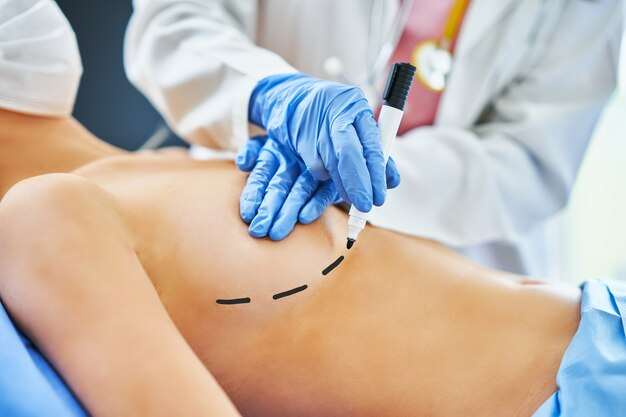Liposuction of the Abdomen: Potential Risks
- EISHA DYNAMIC
- Sep 16, 2024
- 3 min read
Liposuction of the abdomen is a popular cosmetic procedure aimed at removing excess fat and enhancing body contours. While it can be effective for achieving a flatter and more defined abdominal profile, it is important to be aware of the potential risks and complications associated with this procedure. Understanding these risks will help you make an informed decision and prepare for a successful outcome. Here is a detailed overview of the potential risks involved in abdominal Liposuction in Dubai.
Common Risks and Complications
1. Infection
Risk Description: Infections can occur at the incision sites or within the treated areas. Although modern surgical techniques and sterile environments reduce this risk, it is not entirely eliminated.
Prevention and Management: Ensure the procedure is performed in a sterile environment by a qualified surgeon. Follow post-operative care instructions meticulously, including keeping the incision areas clean and dry. Contact your surgeon if you notice signs of infection such as increased redness, swelling, or discharge.
2. Bleeding and Hematomas
Risk Description: Even with advances in liposuction techniques, some bleeding and hematomas (bruises) may occur. These are typically minor but can be more pronounced in some cases.
Prevention and Management: Avoid medications that can increase bleeding risk, such as aspirin or certain anti-inflammatory drugs, before the procedure. Post-operative care, including wearing compression garments and monitoring for excessive bleeding, is essential to manage and minimize hematomas.
3. Seromas
Risk Description: Seromas are fluid collections that can develop in the space where fat was removed. They may require drainage if they become large or symptomatic.
Prevention and Management: Adhere to post-operative care instructions, including wearing compression garments and avoiding excessive physical activity. If a seroma develops, your surgeon may need to perform a minor procedure to drain the fluid.
4. Skin Irregularities and Contour Deformities
Risk Description: Uneven fat removal or poor skin retraction can lead to skin irregularities such as lumps, bumps, or uneven contours.
Prevention and Management: Choose a skilled and experienced surgeon who uses precise techniques to ensure uniform fat removal. If contour irregularities occur, they may be addressed through touch-up procedures or additional treatments.
5. Numbness and Sensory Changes
Risk Description: Temporary or, in rare cases, permanent numbness or altered sensation in the abdomen can occur due to nerve damage or swelling.
Prevention and Management: Most sensory changes resolve over time as healing progresses. Persistent numbness or sensory changes should be discussed with your surgeon for further evaluation and potential management.
Serious Risks and Complications
1. Pulmonary Embolism
Risk Description: A pulmonary embolism is a serious condition that can occur if fat particles enter the bloodstream and travel to the lungs, causing a blockage. This is a rare but potentially life-threatening complication.
Prevention and Management: The risk of pulmonary embolism is minimized by using advanced liposuction techniques and careful preoperative assessments. If you experience symptoms such as chest pain, shortness of breath, or sudden dizziness, seek immediate medical attention.
2. Fat Embolism Syndrome
Risk Description: Fat embolism syndrome occurs when fat globules enter the bloodstream and lodge in various organs, potentially causing serious health issues.
Prevention and Management: This condition is rare with modern liposuction techniques, including abdominal liposuction. Early detection and treatment are crucial if symptoms such as confusion, respiratory distress, or petechial rash develop.
3. Adverse Reactions to Anesthesia
Risk Description: Reactions to local anesthesia or sedation, though uncommon, can occur and may include allergic reactions or complications related to anesthesia administration.
Prevention and Management: Inform your surgeon of any allergies or sensitivities to anesthesia. Your surgical team will monitor you closely during the procedure to manage any adverse reactions promptly.
4. Excessive Fluid Loss
Risk Description: The use of a significant volume of fluid during the procedure can lead to fluid imbalances or dehydration.
Prevention and Management: Surgeons carefully manage fluid levels during the procedure to minimize the risk of excessive fluid loss. Post-operative hydration and adherence to fluid intake recommendations are crucial for recovery.
Post-Operative Care and Recovery
Effective post-operative care is essential to minimize risks and support recovery after abdominal liposuction:
Compression Garments: Wear compression garments as directed by your surgeon to help reduce swelling and support skin retraction.
Activity Restrictions: Avoid strenuous activities and follow guidelines for physical activity to promote healing and reduce the risk of complications.
Follow-Up Appointments: Attend all scheduled follow-up appointments to monitor your progress, address any concerns, and ensure proper healing.
Conclusion
Abdominal liposuction can provide effective fat removal and contour improvement but comes with potential risks and complications. Understanding these risks—such as infection, bleeding, seromas, and serious issues like pulmonary embolism—is crucial for making an informed decision. By choosing a qualified and experienced surgeon, adhering to preoperative and post-operative care instructions, and being aware of potential complications, you can enhance the likelihood of a successful outcome and a smoother recovery. Always consult with your healthcare provider to discuss your individual needs and to determine if abdominal liposuction is the right choice for achieving your cosmetic goals.




Comments